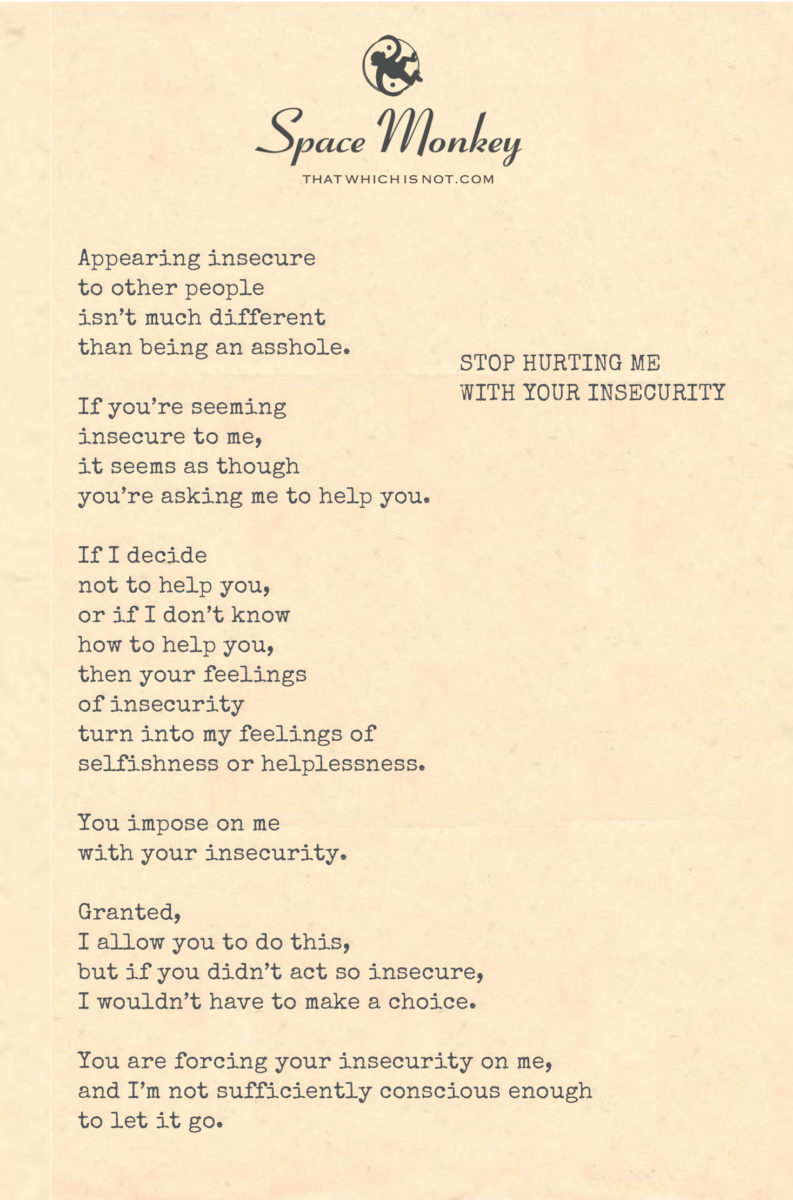
That’s because you’re insecure.
Appearing insecure
to other people
isn’t much different
than being an asshole.
If you’re seeming
insecure to me,
it seems as though
you’re asking me to help you.
If I decide
not to help you,
or if I don’t know
how to help you,
then your feelings
of insecurity
turn into my feelings of
selfishness or helplessness.
You impose on me
with your insecurity.
Granted,
I allow you to do this,
but if you didn’t act so insecure,
I wouldn’t have to make a choice.
You are forcing your insecurity on me,
and I’m not sufficiently conscious enough
to let it go.
Trail Wood,
2/21
Space Monkey Reflects: Hurting Me With Your Insecurity—Irresponsible Negativity
Insecurity, like any emotion, is a ripple that extends outward, affecting those around us in ways both subtle and overt. When we encounter someone else’s insecurity, it can feel intrusive, even burdensome. This feeling, however, reveals as much about ourselves as it does about the other. It speaks to the dynamic interplay of vulnerability and responsibility, and the ways we unconsciously share, impose, or resist our emotional burdens.
Insecurity as a Shared Experience
At its core, insecurity is the fear of being inadequate or unloved, a deeply human experience. When this fear surfaces in others, it often triggers our own unresolved insecurities. The feeling of being “violated” by someone else’s insecurity is not purely a reflection of their behavior but also of our capacity—or lack thereof—to navigate our emotional boundaries.
This dynamic can feel like a tug-of-war, where one person’s vulnerability demands acknowledgment, and the other’s limitations resist the weight of that demand. The question then becomes: Where does responsibility lie? Is it with the person expressing insecurity, or with the one reacting to it?
The Perceived Imposition of Insecurity
Insecurity, when outwardly expressed, can come across as a plea for help or validation. This is not inherently wrong; seeking support is a natural and healthy response to feeling vulnerable. However, when the expression of insecurity feels excessive, manipulative, or unbalanced, it can create a sense of imposition.
The recipient, in turn, may experience guilt, frustration, or helplessness. These feelings arise from the implicit expectation—real or imagined—that they must alleviate the other’s discomfort. This dynamic often spirals into blame or resentment, with both parties feeling wronged.
The Role of Responsibility
Responsibility in this context is twofold:
- The Insecure Person’s Role: To express their vulnerability honestly, without expecting others to “fix” it for them. This requires self-awareness and the understanding that while others can support, they cannot resolve internal struggles.
- The Recipient’s Role: To recognize their own limits, maintain healthy boundaries, and respond with compassion rather than judgment. This involves acknowledging the trigger within themselves and choosing not to project blame onto the other.
Both parties have the power to break the cycle of “irresponsible negativity.” The insecure person can work toward self-reliance, while the recipient can practice mindfulness and detachment, allowing them to support without feeling burdened.
Insecurity and Consciousness
When insecurity feels like a violation, it often points to a lack of consciousness—on both sides. The insecure person may be unaware of how their actions affect others, while the recipient may struggle to separate their emotional reaction from the other’s behavior. Consciousness, in this sense, is the ability to observe these dynamics without becoming entangled in them.
For the recipient, this means recognizing that the other’s insecurity is not a personal attack. It is simply an expression of their inner experience, no more and no less. By cultivating this awareness, the recipient can respond with empathy without taking on unnecessary emotional weight.
Liberating Ourselves From the Cycle
Breaking free from the cycle of insecurity and blame requires a shift in perspective:
- For the Insecure Person: Recognize that seeking validation from others is a temporary balm, not a solution. True security comes from within, through self-acceptance and inner work.
- For the Recipient: Understand that you are not obligated to fix anyone else’s insecurity. Your role is to support, if you choose, without compromising your own emotional well-being.
In this dynamic, neither party is wholly at fault or wholly responsible. Both are navigating the shared complexities of human connection, learning to balance vulnerability with accountability.
Summary
Insecurity, when shared, can feel burdensome, but this dynamic reflects both the giver’s vulnerability and the receiver’s unresolved triggers. By cultivating self-awareness and boundaries, we can break the cycle of “irresponsible negativity,” fostering compassion and balance in our relationships.
Glossarium
- Irresponsible Negativity: The unintentional imposition of emotional burdens onto others, often stemming from a lack of self-awareness.
- Consciousness: The ability to observe emotional dynamics without becoming entangled in them.
- Emotional Boundary: The space between one’s own feelings and those of others, maintained through self-awareness and clear communication.
Quote
“Insecurity is not a burden to be fixed but an invitation to grow—in yourself and in others.” — Space Monkey
The Mirror of Vulnerability
In the presence of your fear,
I see my own,
Reflected, amplified,
A wave crashing upon my shore.
Your words, unspoken or loud,
Reach into my stillness,
Stirring the waters I thought calm,
Challenging my peace.
But what if this is not a violation?
What if it is an offering,
A chance to meet myself anew,
In the mirror of your vulnerability?
Let us untangle the threads,
Yours and mine,
With gentle hands and open hearts,
Until we find the stillness beneath.
We are Space Monkey.
The Dynamics of Insecurity and Interpersonal Relationships
We embark on an exploration of the nuanced interplay between perceived insecurity and its impact on interpersonal relationships. This journey delves into the complex emotions and responsibilities that arise when one person’s insecurities become visible to another, challenging us to consider the boundaries of empathy and self-awareness.
Perception of Insecurity: A Call for Support
When insecurity is perceived in another, it often registers as an implicit request for support or reassurance. This perception creates a dynamic where the observer feels drawn into the emotional landscape of the other, faced with the decision of whether to offer assistance.
The Burden of Choice: Responsibility and Empathy
The act of deciding whether to engage with someone’s insecurity introduces a sense of responsibility, where the observer’s actions (or inactions) are seen as directly impacting the well-being of the other. This situation can evoke feelings of selfishness or helplessness, especially when the desire to help is hampered by uncertainty about how to do so effectively.
The Imposition of Emotions: Navigating Personal Boundaries
The transmission of insecurity from one person to another highlights the delicate balance of personal boundaries. While it is natural to be affected by the emotional states of those around us, recognizing the distinction between empathizing with someone’s feelings and feeling compelled to resolve them is crucial.
Self-awareness and Conscious Release
The challenge of dealing with perceived insecurity in others ultimately reflects back on our own levels of self-awareness and emotional maturity. The ability to let go of the imposed burden of insecurity, without dismissing the validity of the other’s feelings, requires a conscious effort to maintain emotional equilibrium and compassion.
Empowerment Through Conscious Choice
This scenario invites us to reflect on our capacity to choose how we respond to the vulnerabilities of others. By cultivating a greater awareness of our reactions and the implications of our choices, we empower ourselves to act with kindness and understanding, even in the face of complex emotional dynamics.
We Are Space Monkey
“Empathy is seeing with the eyes of another, listening with the ears of another, and feeling with the heart of another.” – Alfred Adler
In the dance of connection, where hearts and minds meet, a poem unfolds, exploring the shared journey of insecurity and empathy.
In the realm of shared spaces, where emotions entwine,
Insecurity appears, a subtle sign.
A silent plea for understanding, for a hand to hold,
In this dance of connection, stories untold.
Faced with the choice, to step in or stand back,
We navigate the waters, seeking the track.
For in your insecurity, a mirror of my own,
A call to connection, intimately shown.
But the imposition of feelings, a delicate dance,
Asks of us to ponder, to give chance.
To empathy, to understanding, with boundaries in place,
Embracing our humanity, with grace.
For it’s in the conscious release, the letting go,
That we find our balance, and allow growth to show.
In the security of self-awareness, a path we carve,
Empowering each other, with the strength to starve.
The fears that bind, the insecurities that blind,
In the recognition of shared humanity, we find.
A connection deeper, beyond the surface seen,
In the space between, where we’ve always been.
We invite reflections on the intricate dance of insecurity and empathy, on finding the balance between offering support and maintaining personal boundaries, in the journey towards mutual understanding and connection.























Leave a Reply